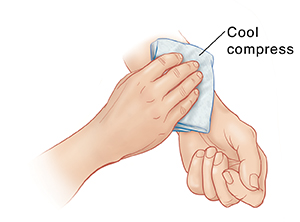Understanding Cercarial Dermatitis
Understanding Cercarial Dermatitis

Cercarial dermatitis is a type of skin rash. The rash is also known as swimmer’s itch. It’s caused by an allergic reaction to tiny parasites. The parasites are sometimes found in water such as lakes, rivers, and the ocean. It can appear about a day after swimming in water with the parasites. It usually happens during the summer months. Cercarial dermatitis is not spread from person to person.
How to say it
Sir-KAYR-ee-uhl der-muh-TY-tis
What causes cercarial dermatitis?
The condition is caused by tiny parasites that attach and go into the skin, and cause an allergic reaction. A cercaria is a larval stage of a parasite that can swim. The parasites are shed into water from the feces of animals such as ducks, seagulls, geese, and snails. The parasites can live in both fresh water and salt water. They can't live or reproduce in your skin. But they can cause an uncomfortable allergic reaction.
Swimmer’s itch is not the same as seabather’s eruption, which is caused by tiny jellyfish larvae. Seabather’s eruption occurs on skin covered by swim clothing that traps jellyfish larvae. Cercarial dermatitis occurs on bare skin not covered by clothing.
Because the cercarial dermatitis rash is an allergic reaction, your body may react more strongly each time you are exposed to the parasites. You may have symptoms quicker, and they may be worse.
Symptoms of cercarial dermatitis
The skin symptoms include:
-
Burning
-
Itching
-
Red bumps that may look like pimples, hives, or blisters
Treatment for cercarial dermatitis
The rash will go away in a few weeks to a month. Make sure to prevent infection by not scratching it. You can treat itching with any of these:
-
Cool, moist compress. Put a clean damp cloth on the area for 20 to 30 minutes, 5 to 6 times a day as needed.
-
Corticosteroid cream or ointment. You can apply this medicine several times a day on clean skin.
-
Antihistamine. This medicine can help ease itching. You can put it on your skin as a cream, or take it by mouth as a pill.
-
Colloidal oatmeal bath. Soaking in water with colloidal oatmeal can help soothe itchy skin.
-
Baking soda paste. This can help relieve itching. Mix baking soda with water into a paste. Put it on your rash.
-
Other anti-itch lotion or cream. Ask your healthcare provider about other anti-itch lotion or cream that can help relieve itching. He or she may prescribe a stronger medicine if drugstore medicine isn’t helping you.
The best way to avoid getting the rash is to stay out of lakes or bodies of water known to be infested.
Possible complications of cercarial dermatitis
Scratching can cause a bacterial skin infection. An infection may need to be treated with antibiotic medicine. This can be put on the skin as a cream or ointment, or taken by mouth as a pill.
When to call your healthcare provider
Call your healthcare provider right away if you have any of these:
-
Fever of 100.4°F (38°C) or higher, or as directed by your healthcare provider
-
Symptoms that don’t get better, or get worse
-
New symptoms
Updated:
September 22, 2020
Sources:
Brant SV, et al. Cercarial Dermatitis Transmitted by Exotic Marine Snail. Emergency Infectious Disease. 2010 September;16(9):1357-65., Kolarova L, et al. Cercarial dermatitis, a neglected allergic disease. Clinical Rev Allergy Immunol. 2012 August;45(1):63-74.Ferri F., Levesque B, et al. Investigation of an outbreak of cercarial dermatitis. Epidemiology Infection. 2002 October;129(2):379-86., Wilson ME. Skin lesions in the returning traveler. Up To Date. July 21 ed: Up To Date; 2015. p. 40.
Reviewed By:
Michael Lehrer MD,Rita Sather RN,L Renee Watson MSN RN